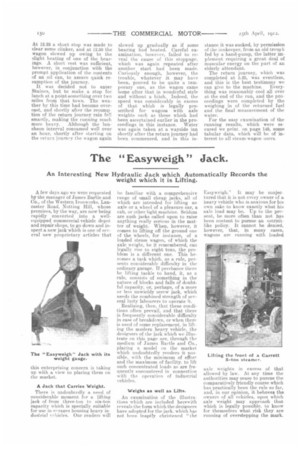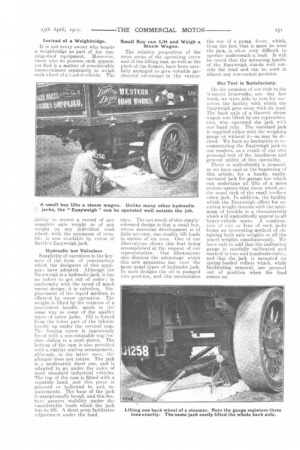The "Ea.syweigh" Jack.
Page 6

Page 7

If you've noticed an error in this article please click here to report it so we can fix it.
An Interesting New Hydraulic Jack which Automatically Records the weight which it is Lifting.
A few days ago we were requested by the manager of James Bartle and Co., of the Western Ironworks, Lancaster Road, Notting Hill, whose premises, by the way, are now being rapidly converted into a wellequipped commercial-vehicle depot and repair shops, to go down and inspect a new jack which is one of several new proprietary articles that
this enterprising concern is taking up with a view to placing them on the market.
A Jack that Carries Weight.
There is undoubtedly a need of considerable moment for a lifting jack of from three-ton to six-ton capacity which is specially suitable for use in eerages housing heavy industrial vehicles, Our readers will be familiar with a comprehensive range of small cheap jacks, all of which are intended for lifting an axle or a, wheel of a pleasure car, a cab, or other light machine. Seldom are such jacks called upon to raise anything really serious in the matter of weight. When, however, it comes to lifting off the ground one of the wheels, for instance, of a. loaded steam wagon, of which the axle weight, be it remembered, can legally rise to eight tons, the problem is a different one. This becomes a task which, as a rule, presents considerable difficulty in the ordinary garage. If perchance there be lifting tackle to hand, it, as a rule, consists of something in the nature of blocks and falls of doubtful capacity. or, perhaps, of a more or less unwieldy screw jack, which needs the combined strength of several lusty labourers to operate it.
Realizing, then, that these conditions often prevail, and that there is frequently considerable difficulty in ease of breakdown, or when there is need of some replacement, in lifting the modern heavy vehicle, the designers of the jack which we illustrate on this page are, through the medium of James -Bartle and Co., placing a model on the market which undoubtedly renders it possible, with the minimum of effort and the maximum of facility, to lift such concentrated loads as are frequently encountered in connection with the operation of industrial vehicles.
Weighs as well as Lifts.
An examination of the illustrations which are included herewith reveals the form which the designers have adopted for the jack, which has not been inaptly christened " the Easyweigh." It may be conjectured that it is not every owner of a heavy vehicle who is anxious for his own sake to know exactly what his axle load may be. Up to the present, he more often than not has been content to pursue an ostrichlike policy. It cannot be denied, however, that, in many ca,ses,, wagons are running with loaded axle weights in excess of that allowed by law. At any time the authorities may cease to pursue the comparatively friendly caurse which has practically been the rule so far, and, in our opinion, it behoves the owners of all vehicles, upon which axle weight may approach that which is legally possible. to know for themselves what risk they are running of overstepping the mark. ability to secure a record of any complete axle weight or of any weight on any individual road wheel, with the minimum of trouble, is now available by virtue of Bartle's Easyweigh jack. Instead of a Weighbridge.
It is not every owner who boasts a weighbridge as part of his running-shed equipment. Moreover, those who do possess such apparatus fiud it a matter of considerable inconvenience separately to. weigh each wheel of a leaded vehicle. The
Hydraulic but Valveless
Simplicity of operation is the keynote of the form of construction which the designers of this appliance have adopted. Although the Easyweigh is a hydraulic jack, it has no valves to get out of order ; in conformity with the trend of much recent design, it is valveless. Displacement of the liquid medium is effected by screw operation. The weight is lifted by the rotation of a convenient handle. much in the same way as some of the smaller types of screw jacks. Oil is forced from the. lower part, of the tubular brindle up under the vertical ram. The forcing screw is ingeniously fitted with a non-rotatable cup leather sliding in a steel sleeve. The bottom of the ram is also provided with a similar sealing arrangement. although, in the latter case, the plunger does not rotate. The jack is a moderately short one, and is adapted to go under the axles of most standard industrial vehicles. The, top of the ram is fitted with a separate head, and this piece is grooved or hollowed to suit requirements. The base of the jack is exceptionally broad, and this feature assures stability under the considerable loads which the jack has to lift. A short prop facilitates adjustment under the load, Small By can Lift and Weigh a Stearn Wagon.
The relative proportion of the cross areas of the operating screw and of the lifting ram, as well as the pitch of the former, have been carefully arranged to give suitable mechanical advantage in the various sizes. The net result of this simplyschemed design is that a small boy. whose muscular development, is of little account, can readily lift loads in excess of six tons. One of our illustrations shows this feat being accomplished at the request of our representative. Our illustrations also disclose the advantage which this new apparatus has over the more usual types of hydraulic jack. In such designs the oil is pumped into position, and this necessitates the use of a pump lever, which, front the fact that it must be near the jack, is often very difficult to operate underneath a load. It will be noted that the actuating handle of the Easyweigh stands well outside the load and can be used in almost any convenient position.
Our 'rest is Satisfactory.
On the occasion of our visit, to the Western Ironworks, one day last. week, we were able to test for ourselves the facility with which the Easyweigh gets away with its load. The back axle of a Garrett. steam wagon was lifted by our representative, who operated the jack with one hand only. The standard jack is supplied either with the weighing gauge or without it—as may be desired. We have no hesitation in recommending the Easyweigh jack to our readers, as a result of our own. personal test of the handiness and general utility of this speciality.
There is undoubtedly a demand. .as we have said at the beginning of this article, for a handy, easilyoperated jack for garage use which can undertake all lifts of a more serious nature than those which are: the usual task of the small toolbox screw jack. In addition, the facility which the Easyweigh offers for securing weight records with the minimum of trouble is a characteristic which will undoubtedly appeal to all heavy-vehicle users. A combination of two or four of such jacks forms an interesting method of obtaining both axle weights or all the wheel weights simultaneously. We have only to add that the indicating gauge is carefully calibrated and marked in tons and hundredweights, and that the jack is mounted on spring-loaded rollers which, while facilitating removal, are pressed out of position when the load comes on.




















